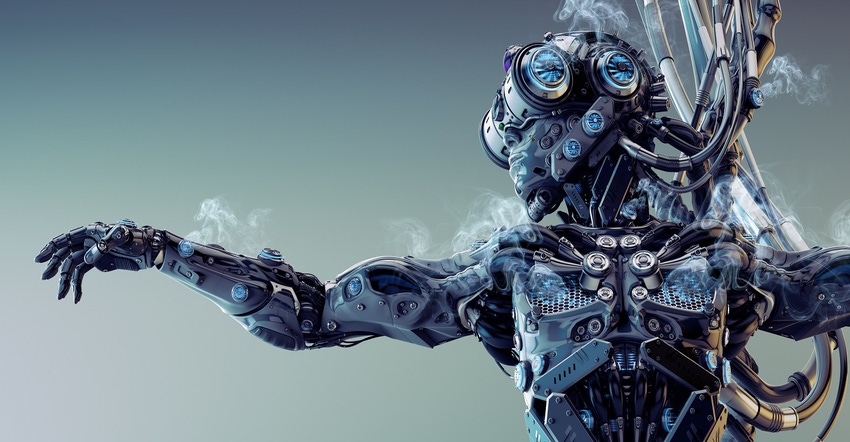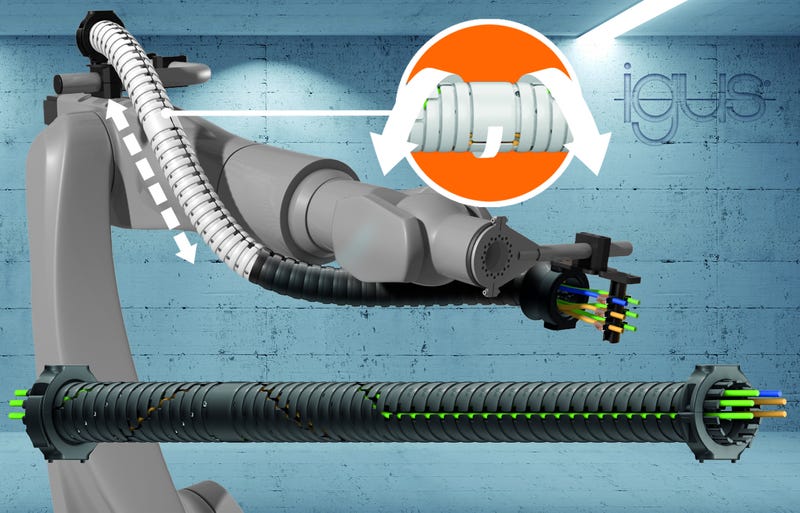How to Build a Better System of Cables for Multi-Axis Robots
David Sandiland from igus explains how telescopic triflex TRX energy chains save space on the robot and ensure a retraction length of up to 40%--and why that matters.
May 31, 2021

Industrial robots are becoming more agile and flexible. As robots technology advances, the supply chain has to respond in kind. You can’t have a robot with greater capability only to be hamstrung by clunky cables. To ensure that cables on industrial robots can be guided in motion safely, easily, and compactly, igus has developed a four-dimensional triflex TRX energy chain.
The cables are placed in the chain in the form of a spiral and are guided safely in the movement with the help of the chain. In addition, the cables and hoses are fastened in place in the middle of the TRX so that they do not leave their position when the chain is pulled.
We caught up with David Sandiland, head of troubleshooting and process improvement in robotics and automation at igus. He explained how cable technology has grown to match advances in robotics.
Design News: How are advances in robotics creating the need for new developments in cables?
David Sandiland: This is a “footprint” change. The reality of new robots and even previously deployed robots are peripheral parts suppliers are all fighting for the same space and that is axis 3. The majority of retraction systems are mounted to a set of holes at the 3rd axis and oftentimes, the integrator or end-user wants that real estate for junction boxes and valve banks. This is particularly common with material handling robots that have large grippers and need several airlines and sensor cables to originate from a junction point at axis 3. The TRX allows us to offer a form of retraction while not occupying the “high rent” district of the robot arm.

DN: Explain the Triflex R energy chain and how it works.
David Sandiland: Triflex R is a three-dimensional cable carrier that incorporates the benefits of a standard 2-D cable carrier, like bend radius protection and interior separation, but also adds other features like a torsion stop and ball and socket design. The combination of these four features is unique to triflex R and leads to greater cable protection and reduced downtime. A lot of robot cable management is done using a corrugated hose, but the corrugated hose resists bending and twisting. It also does not offer interior separation nor can it be lengthened/shortened or repaired without replacing the entire tube. Triflex R can do all of these things and the bottom line is that it saves customers money in downtime, maintenance turnaround time, and waste.
DN: Since continual contraction causes strain on cable materials, how igus has tested the material under continued stress?
David Sandiland: Banded systems are something that we already use in some of our retraction systems and we have gone through extensive testing to find bands that provide the correct amount of tension as well as a long lifecycle. We have had banded solutions in our retraction systems for approximately five years now. In the case of the TRX, the bands will behave similarly to the ones in retraction systems. Igus has a large test lab at our headquarters in Cologne Germany. We have several robots and test fixtures that our product development team utilizes to test our new designs. We are currently testing a TRX system on one of our robots and I can say as of today the results are very positive! We will run this test in-house for several million cycles before we make this available to the market. There are also plans to test TRX in partnership with some of our automotive partners in Europe. Our goal is to have TRX available to the market by the fourth quarter.
DN: How does weight reduction affect robot performance?
David Sandiland: There is a fight for real estate on the robot at axis 3. This is also true when it comes to the payload. Each robot has a maximum payload, and everything that is added to the robot contributes to reducing the robot’s capabilities. When you add peripherals like cable management or junction boxes to a robot, it limits the robot’s available payload when it comes to the size of the tooling and the job that it does. By eliminating the retraction system, you drop the overall weight of the cable management system by as much as 10kg. This is a significant amount when engineers are designing around 40kg or 50kg capacity robots.
DN: Does this cable development has applications beyond robotics?
David Sandiland: At this point, it is hard to say whether we will see non-robotic applications gravitate towards this solution, but I can tell you that we frequently collaborate with companies on triflex R projects for non-robotic applications. These applications range from amusement park rides to medical equipment to machine tools. With that in mind, I’m sure there will be an opportunity down the road to incorporate TRX into a non-robotic application.
Rob Spiegel has covered manufacturing for 19 years, 17 of them for Design News. Other topics he has covered include automation, supply chain technology, alternative energy, and cybersecurity. For 10 years, he was the owner and publisher of the food magazine Chile Pepper.
About the Author(s)
You May Also Like




